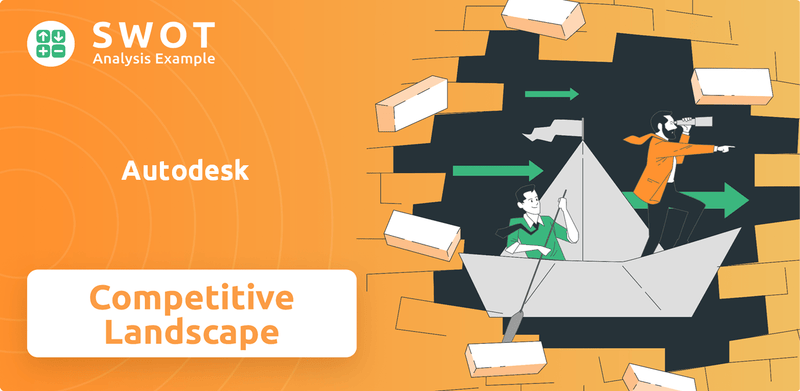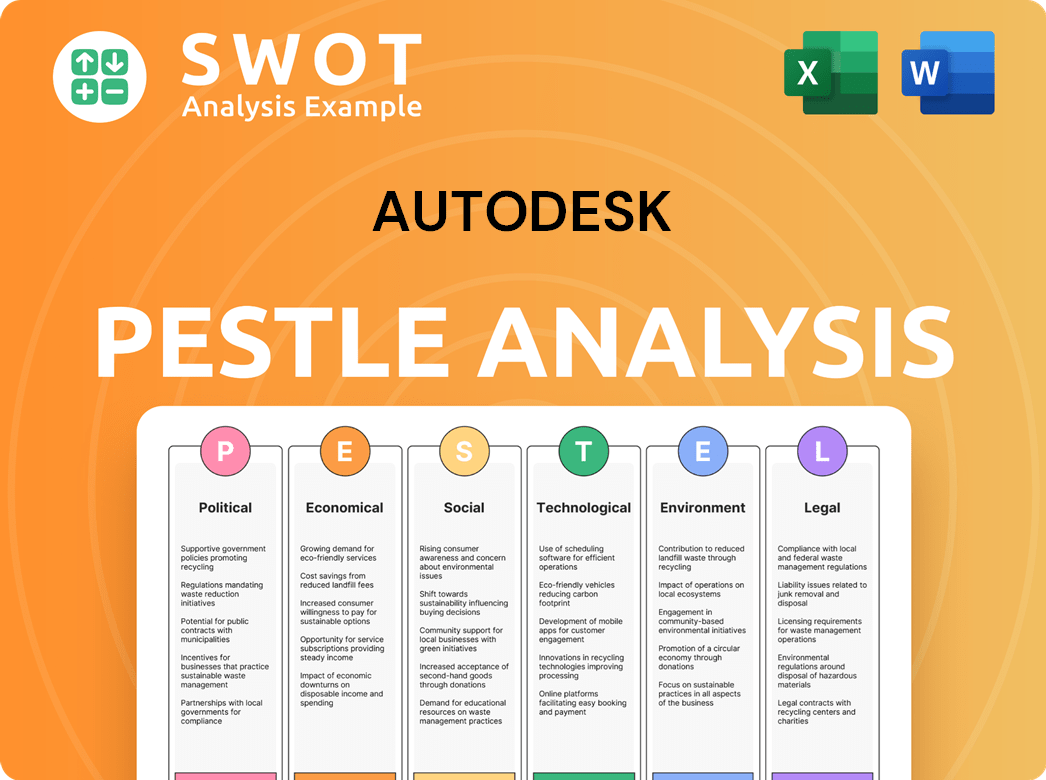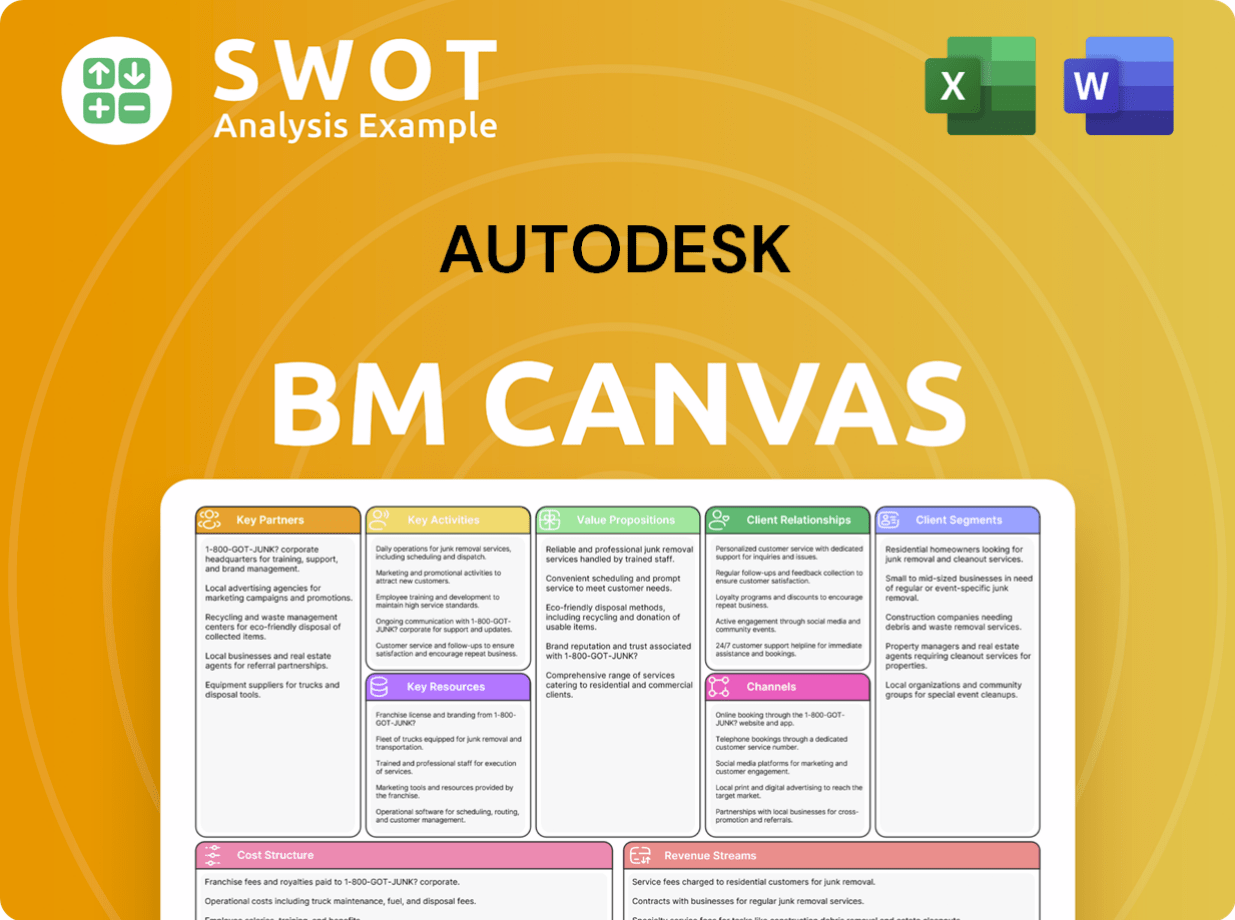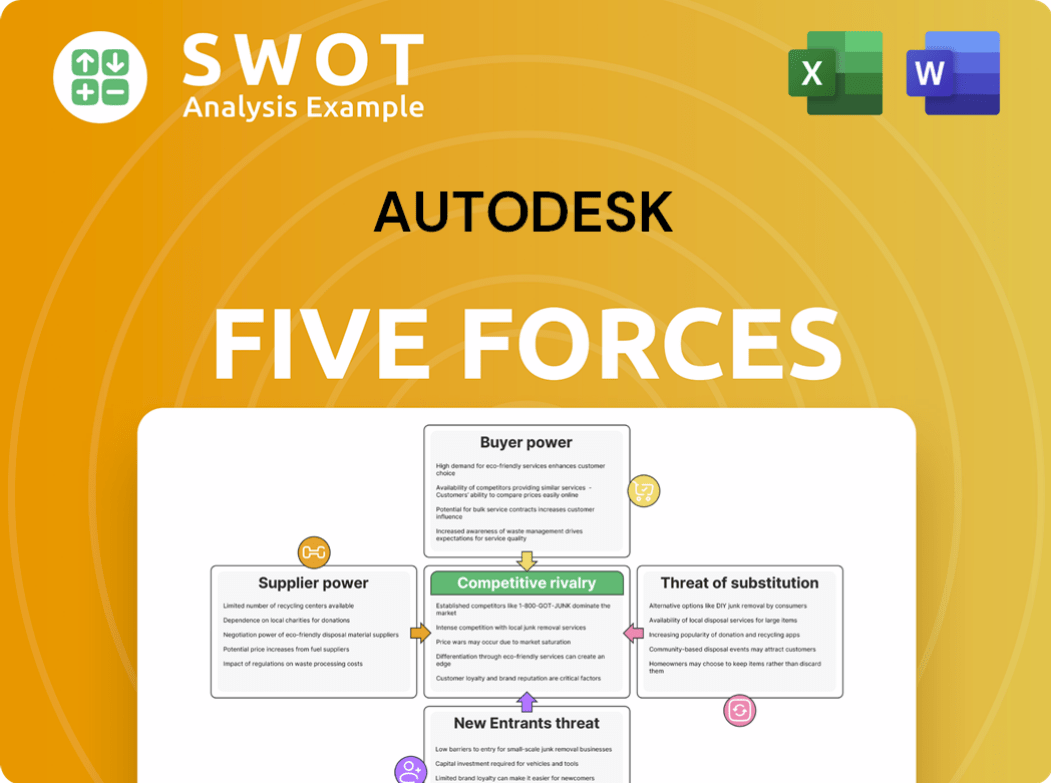Autodesk Bundle
Can Autodesk Maintain Its Dominance in a Cutthroat Market?
Autodesk, a titan in the design and engineering software arena, continually pushes the boundaries of innovation. Its strategic focus on cloud-based solutions and AI integration signals a commitment to staying ahead. But in a world of relentless technological advancements, understanding the Autodesk SWOT Analysis is crucial to assess its position.

This exploration delves into the Autodesk competitive landscape, dissecting its position within the Autodesk software market and identifying key Autodesk competitors. We will analyze the company's Autodesk market share against rivals, providing an Autodesk industry analysis to reveal its competitive advantages and address challenges. Understanding the dynamics of CAD software competition is essential for investors, strategists, and anyone seeking to navigate the complexities of this dynamic sector, including assessing Autodesk Revit alternatives and the landscape of Autodesk AutoCAD competitors 2024.
Where Does Autodesk’ Stand in the Current Market?
Autodesk has a strong market position, especially in the architecture, engineering, and construction (AEC) and manufacturing sectors. Its comprehensive suite of design and make software drives this position. The company's flagship products, such as AutoCAD, Revit, and Fusion 360, are often considered industry standards. For instance, in the AEC sector, Revit holds a dominant position for Building Information Modeling (BIM), which is essential for integrated project delivery.
Autodesk's move to a subscription-based model has strengthened its recurring revenue streams and customer relationships. This shift has allowed for greater flexibility, scalability, and access to its extensive software portfolio. Autodesk serves a broad customer base, ranging from large enterprises and government agencies to small and medium-sized businesses and individual professionals across North America, Europe, and Asia.
The company's digital transformation has enabled it to better serve evolving customer needs, including remote collaboration and data-driven insights. Financially, Autodesk demonstrates robust health, with reported revenues of $5.5 billion for fiscal year 2024, representing a 9% increase year-over-year. This financial scale, coupled with consistent investment in research and development, positions Autodesk favorably against industry averages.
Autodesk's market share varies by product line and region, but its core products like AutoCAD and Revit often lead the CAD software market. In the AEC sector, Revit's dominance in BIM is a key factor. The company's strong position is supported by its extensive customer base and brand recognition.
The transition to a subscription-based model has significantly impacted Autodesk's financial performance. This model provides predictable revenue streams and fosters stronger customer relationships. This shift has also allowed the company to offer more flexible and scalable software solutions.
Autodesk serves a diverse customer base globally, including large enterprises, SMBs, and individual professionals. Its products are used across various industries, including architecture, engineering, construction, manufacturing, and media and entertainment. The company's global presence is a key strength.
Autodesk's financial performance is robust, with $5.5 billion in revenue for fiscal year 2024, demonstrating a 9% year-over-year increase. The company consistently invests in research and development, ensuring it remains competitive. This investment is crucial for maintaining its market position and driving innovation.
Autodesk's market position is defined by its strong brand, comprehensive product portfolio, and strategic shift to a subscription model. The company's focus on innovation and customer needs has helped it maintain a competitive edge. For further insights, explore the Growth Strategy of Autodesk.
- Dominant in AEC and manufacturing sectors.
- Subscription model drives recurring revenue.
- Strong financial performance with consistent R&D investment.
- Global customer base across various industries.
Autodesk SWOT Analysis
- Complete SWOT Breakdown
- Fully Customizable
- Editable in Excel & Word
- Professional Formatting
- Investor-Ready Format

Who Are the Main Competitors Challenging Autodesk?
The Autodesk competitive landscape is complex, with various competitors vying for market share across its diverse software offerings. This landscape is shaped by direct rivals, indirect competitors, and emerging players, each presenting unique challenges and opportunities. Understanding the competitive environment is crucial for assessing Autodesk market share and its future growth prospects.
Autodesk industry analysis reveals a dynamic market where innovation and strategic partnerships play significant roles. The company faces competition in several key areas, including architecture, engineering, construction (AEC), manufacturing, and media and entertainment. This Autodesk software market is influenced by technological advancements, evolving customer needs, and the ongoing shift towards cloud-based solutions.
Autodesk competitors vary depending on the specific software segment. In the AEC sector, Bentley Systems and Nemetschek Group are key rivals. Dassault Systèmes competes in manufacturing, while Adobe poses a challenge in media and entertainment. The competitive landscape is also affected by open-source alternatives and the increasing integration of AI.
Bentley Systems, with MicroStation and OpenBuildings Designer, targets large infrastructure projects. Nemetschek Group, including Allplan and Graphisoft (ArchiCAD), focuses on BIM and architectural design, especially in Europe. These companies directly compete with Autodesk's Revit and AutoCAD.
Dassault Systèmes, through SolidWorks and CATIA, offers comprehensive PLM solutions, competing with Autodesk Fusion 360 and Inventor. Siemens PLM is another major player in this space. These competitors often challenge Autodesk for enterprise clients.
Adobe's Creative Cloud suite, particularly video editing and motion graphics tools, competes indirectly with Autodesk's Maya and 3ds Max. Emerging players and open-source options also provide alternatives for niche areas. These competitors offer specialized tools or lower-cost solutions.
Strategic partnerships and acquisitions influence the competitive dynamics. Companies consolidate market share and expand technological capabilities. The integration of AI and machine learning is becoming a new battleground.
Emerging players and open-source alternatives provide specialized tools or lower-cost solutions. They pose challenges in niche areas and for budget-conscious users. This competition drives innovation and price sensitivity.
The increasing integration of AI and machine learning into design software is a new battleground. Companies are vying to offer the most intelligent and automated design workflows. This technology is reshaping the Autodesk competitive landscape.
The competition in the CAD software market is intense, with each company striving to provide superior solutions and capture a larger share of the market. Understanding the strengths and weaknesses of each competitor is essential for strategic decision-making. For more insights into the financial aspects of the company, consider exploring the information on Owners & Shareholders of Autodesk.
- Autodesk vs Dassault Systèmes: Dassault Systèmes is a major competitor, particularly in the manufacturing sector, offering comprehensive PLM solutions.
- Autodesk Revit alternatives: Bentley Systems and Nemetschek Group are key alternatives in the AEC space, providing BIM solutions.
- Autodesk AutoCAD competitors 2024: AutoCAD faces competition from various CAD software providers, including those mentioned above and open-source alternatives.
- Autodesk Fusion 360 competitors: Dassault Systèmes and Siemens PLM are significant competitors in the product design and manufacturing space.
- Autodesk Maya competitors: Adobe's Creative Cloud suite is an indirect competitor in the media and entertainment industry.
Autodesk PESTLE Analysis
- Covers All 6 PESTLE Categories
- No Research Needed – Save Hours of Work
- Built by Experts, Trusted by Consultants
- Instant Download, Ready to Use
- 100% Editable, Fully Customizable

What Gives Autodesk a Competitive Edge Over Its Rivals?
Understanding the competitive advantages of any company is crucial for investors and industry analysts. In the context of the Autodesk target market, several factors contribute to its strong position within the Autodesk competitive landscape. These advantages are not static; they require constant adaptation to maintain their effectiveness against evolving market dynamics and the emergence of new Autodesk competitors.
Autodesk's success is built upon a foundation of proprietary technology, brand recognition, and a vast ecosystem. These elements create a significant barrier to entry for new players in the Autodesk software market. The company's ability to innovate and adapt to industry changes is critical for sustaining its competitive edge.
The company's financial performance, including its investment in research and development, reflects its commitment to maintaining its competitive advantages. This commitment is essential for navigating the challenges and opportunities within the CAD software competition and the broader Autodesk industry analysis.
Autodesk leverages proprietary technologies like the .dwg file format for AutoCAD and BIM technology in Revit. These technologies create a significant barrier to entry, fostering customer lock-in. Switching platforms is challenging due to interoperability issues, solidifying Autodesk's market position.
Autodesk has built exceptional brand recognition over decades. Its reputation for reliable and innovative design solutions fosters high customer loyalty. Professionals invest significant time and resources in mastering Autodesk products, reinforcing their commitment to the platform.
Economies of scale allow Autodesk to invest heavily in research and development (R&D). In fiscal year 2024, R&D expenses were reported at $1.2 billion. This investment fuels the development of new features, cloud capabilities, and AI integrations, ensuring its products remain at the forefront of technological advancement.
Autodesk's extensive distribution network, including direct sales, resellers, and an online store, ensures broad market reach. The company also benefits from a robust talent pool, attracting top engineers and designers. These factors contribute to its overall market strength and competitive advantages.
Autodesk's competitive advantages are multifaceted, encompassing technological, brand-related, and operational aspects. These advantages are crucial for navigating the Autodesk competitors landscape and maintaining market share. Continuous innovation and strategic adaptation are vital to sustain these advantages.
- Proprietary technologies and file formats create customer lock-in.
- Strong brand recognition and customer loyalty built over decades.
- Significant investment in R&D, with $1.2 billion spent in fiscal year 2024.
- Extensive distribution network and a strong talent pool.
Autodesk Business Model Canvas
- Complete 9-Block Business Model Canvas
- Effortlessly Communicate Your Business Strategy
- Investor-Ready BMC Format
- 100% Editable and Customizable
- Clear and Structured Layout

What Industry Trends Are Reshaping Autodesk’s Competitive Landscape?
The Autodesk competitive landscape is dynamic, shaped by industry trends, technological advancements, and economic factors. The company faces both opportunities and challenges as it navigates the evolving software market. Understanding these elements is crucial for assessing its future prospects and strategic direction. This Autodesk industry analysis reveals key areas impacting its position.
Autodesk's market share in the CAD software competition is significant, but it is challenged by various competitors. The rise of cloud computing, AI integration, and sustainability demands are reshaping the industry. Navigating these shifts requires strategic adaptation and innovation to maintain its competitive edge and financial performance. For a deeper dive, consider exploring the Marketing Strategy of Autodesk.
Cloud computing is becoming essential, with the cloud CAD market projected to reach $3.5 billion by 2025. AI and ML are integrating into design workflows, leading to generative design and automation. Sustainability is driving demand for software that supports green building practices.
Aggressive pricing from competitors, such as Autodesk AutoCAD competitors 2024, poses a threat. Niche software solutions addressing specific industry needs could gain traction. Open-source alternatives offer cost-effective options. Economic shifts and supply chain disruptions can impact customer investment.
Emerging markets offer significant growth potential due to infrastructure development. Advanced simulation capabilities and digital twin technology can enhance product offerings. Strategic partnerships with construction technology firms can expand market reach.
Key Autodesk competitors include Dassault Systèmes and Siemens PLM. Autodesk vs Dassault Systèmes and Autodesk vs Siemens PLM are frequently compared. The competitive landscape is also influenced by niche players and open-source options.
To maintain its competitive edge, Autodesk must focus on strategic areas. These include cloud platform development, AI and ML integration, and expansion into emerging markets. The company must also address competitive pricing pressures and explore partnerships.
- Enhance cloud-based solutions to compete with Autodesk Revit alternatives.
- Invest in AI and ML for generative design and predictive analytics.
- Expand offerings to support sustainable design and construction.
- Explore strategic partnerships to broaden market reach.
Autodesk Porter's Five Forces Analysis
- Covers All 5 Competitive Forces in Detail
- Structured for Consultants, Students, and Founders
- 100% Editable in Microsoft Word & Excel
- Instant Digital Download – Use Immediately
- Compatible with Mac & PC – Fully Unlocked

Related Blogs
- What are Mission Vision & Core Values of Autodesk Company?
- What is Growth Strategy and Future Prospects of Autodesk Company?
- How Does Autodesk Company Work?
- What is Sales and Marketing Strategy of Autodesk Company?
- What is Brief History of Autodesk Company?
- Who Owns Autodesk Company?
- What is Customer Demographics and Target Market of Autodesk Company?
Disclaimer
All information, articles, and product details provided on this website are for general informational and educational purposes only. We do not claim any ownership over, nor do we intend to infringe upon, any trademarks, copyrights, logos, brand names, or other intellectual property mentioned or depicted on this site. Such intellectual property remains the property of its respective owners, and any references here are made solely for identification or informational purposes, without implying any affiliation, endorsement, or partnership.
We make no representations or warranties, express or implied, regarding the accuracy, completeness, or suitability of any content or products presented. Nothing on this website should be construed as legal, tax, investment, financial, medical, or other professional advice. In addition, no part of this site—including articles or product references—constitutes a solicitation, recommendation, endorsement, advertisement, or offer to buy or sell any securities, franchises, or other financial instruments, particularly in jurisdictions where such activity would be unlawful.
All content is of a general nature and may not address the specific circumstances of any individual or entity. It is not a substitute for professional advice or services. Any actions you take based on the information provided here are strictly at your own risk. You accept full responsibility for any decisions or outcomes arising from your use of this website and agree to release us from any liability in connection with your use of, or reliance upon, the content or products found herein.